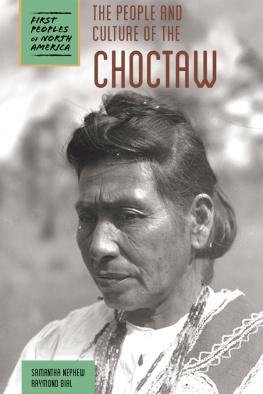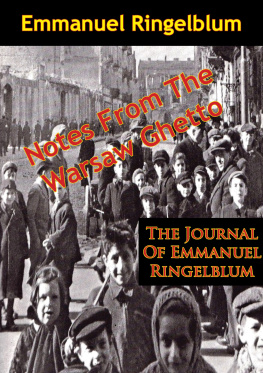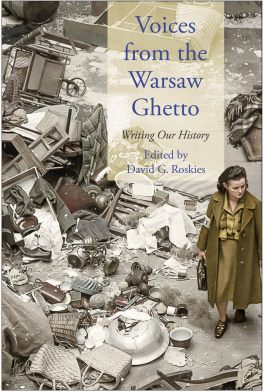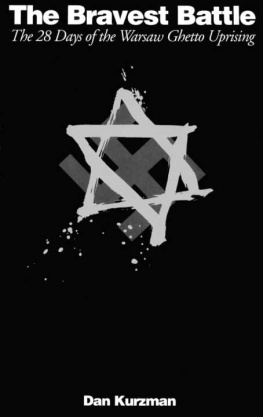Library of Congress Cataloging-in
Publication Data
Names: Baskind, Samantha, author.
Title: The Warsaw Ghetto in American art and culture / Samantha Baskind.
Description: University Park, Pennsylvania : The Pennsylvania State University Press, [2018] | Includes bibliographical references and index.
Summary: An interdisciplinary study examining the diverse meanings of the Warsaw Ghetto in American culture. Looks at how the ghetto has been represented in fine art, book illustrations, film, television, radio, theater, fiction, poetry, and comicsProvided by publisher.
Identifiers: LCCN 2017031182 | ISBN 9780271078700 (cloth : alk. paper)
Subjects: LCSH: Getto warszawskie (Warsaw, Poland)In popular culture. | Jews in popular cultureUnited States.
Classification: LCC NX652.J48 B28 2018 | DDC 700/.43529924dc23
LC record available at https://lccn.loc.gov/2017031182
Copyright 2018 Samantha Baskind
All rights reserved
Printed in China
Published by The Pennsylvania
State University Press,
University Park, PA 16802-1003
The Pennsylvania State University Press is a member of the Association of American University Presses.
It is the policy of The Pennsylvania State University Press to use acid-free paper. Publications on uncoated stock satisfy the minimum requirements of American National Standard for Information SciencesPermanence of Paper for Printed Library Material,
ANSI Z39.481992.
In memory of Mary D. Sheriff,
mentor, shining example, and friend
Every reserve I have as a scholar and a person was tapped to write about this history. The invigoration of discovery and my love of crafting words and arguments remained, but the challenges of the subject matter often left me crushed and questioning my choice to write about the Holocaust. Throughout, I felt nourished by my wondrous children, Asher Solomon Baskind and Naomi Margalit Baskind, who inspire me to reach higher in all areas. Yet they also served to remind me of the devastating loss of life, families, and the unfathomable pain of mothers who watched their children suffer and die. On days that I felt the weight of my subject matter most heavily, I pondered my motives. Eventually I came to understand why I felt compelled to write about the Warsaw Ghetto: I wrote this book for readers, so that they might better understand how vividly culture, politics, and Jewish history intersect; for me, as a scholar and a Jew; and for Asher and Naomi, who will someday learn about the tragic history of our people, and the family lost to us, unknown forever.
A number of institutions and individuals made it possible for me to research and write this manuscript, and it is a pleasure to acknowledge their support. I offer sincerest thanks to Motl Didner of the YIVO Institute for Jewish Research for providing me with his unpublished translation of Der Nes in Geto . Jane Klain at the Paley Center for Media could not have been more generous during my visits to study and transcribe Serlings In the Presence of Mine Enemies . I recognize Ellie Kellman for introducing me to the magazine World Over . Sherri Long at Bowling Green State University came through in a pinch with two key illustrations. The Joe Kubert Estate, Joanne Wilson Jaffe of the Ben and Evelyn Wilson Foundation, Jon Bogdanove, Judy Chicago, Bernice Eisenstein, Audrey Flack, Trina Robbins, Donald Woodman, George Krevsky Gallery, and Pucker Gallery were especially considerate with illustrations and permissions. Tina Sells assistance with grant writing was, as always, unsurpassed.
Gracious colleagues read drafts of chapters at various stages, helping me to navigate thorny issues. For their insightful comments I gratefully acknowledge the expertise of Stephen Bergson and Natasha Goldman. Jeff Karems keen eye made the Uris chapter immeasurably stronger. Laura Levitts careful attention to my discussion of children in the ghetto was crucial to the ultimate shape of those chapters. Ellen Landau, Ranen Omer-Sherman , Andrea Pappas, and Larry Silver have been steady intellectual companions on this project and many others over the years. I thank them profusely for their constructive advice on prose and argument, and for many years of rewarding friendship. To Sean Martin I extend my warmest appreciation for countless conversations about Polish Jewry and his genuine excitement for my work. Richard Romaniuk, I thank you for walking with me along the border of the former Warsaw Ghetto and through its confines.
I am very fortunate to have received vital institutional funding from external sources. A fellowship from the Holocaust Educational Foundation to study at Northwestern University with like-minded colleagues proved invaluable in the early stages. Special mention goes to Paul Jaskot, Michael Rotenberg-Schwartz , and David Dennis for their collegiality. Just as essential was a Curt C. and Else Silberman Seminar fellowship at the United States Holocaust Memorial Museum. I am grateful to have received the Edwin Gale Fellowship from the Harry Ransom Center in Austin, Texas, to examine Leon Uriss archive. Closer to home, Cleveland State University provided financial support, enabling me to visit the Wisconsin Center for Film and Theater Research, where I consulted the Rod Serling Papers and Millard Lampell Papers. The reproductions in this book were made possible by the Faculty Scholarship Initiative Fund and the Deans Office in the College of Liberal Arts and Social Sciences at Cleveland State University.
How lucky I am to work with the Pennsylvania State University Press. I thank Jennifer Norton, Patty Mitchell, and Laura Reed-Morrisson for their behind-the -scenes stewardship. Ellie Goodmans ongoing enthusiasm for my work and sharp editorial eye, and dynamic press director Patrick Alexanders professional camaraderie, mean so much to me. I would also like to single out Rachel Arzuaga, Jessica Ritsko, and Elizabeth Sisley, students extraordinaire. Scott Simons friendship and grammatical prowess are unparalleled. I recognize the tremendous support of my mother, Julie Baskind, who cares for my children when I travel for long periods to archives and abroad.
Portions of chapters first appeared in A Warsaw Ghetto TV Drama from Mr. Twilight Zone, Forward, April 19, 2016; Leon Uriss Mila 18, Muscular Judaism, and the Warsaw Ghetto Uprising in American Culture, in Absorbing Encounters: Constructing American Jewry in the Post-Holocaust Decades, ed. Eliyana Adler and Sheila Jelen (Detroit: Wayne State University Press, 2017), 21543; and Picturing The Holiest Thing: Joe Kuberts Children of the Warsaw Ghetto, in Visualizing Jewish Narrative: Jewish Comics and Graphic Novels, ed. Derek Parker Royal (London: Bloomsbury Academic, 2016), 17184.
Finally, I dedicate this book to Mary D. Sheriff. It is with a heavy heart that the last sentences I write as I finish this projects journey to publication are for her. Without Mary, my book would have never existed. No books I wrote in the past or will write in the future would exist. Words are meager to convey her generosity of time and spirit, inexhaustible encouragement and devotion to her students, and intellectual rigor. And so with all my love and admiration and gratitude, I remember Mary.









